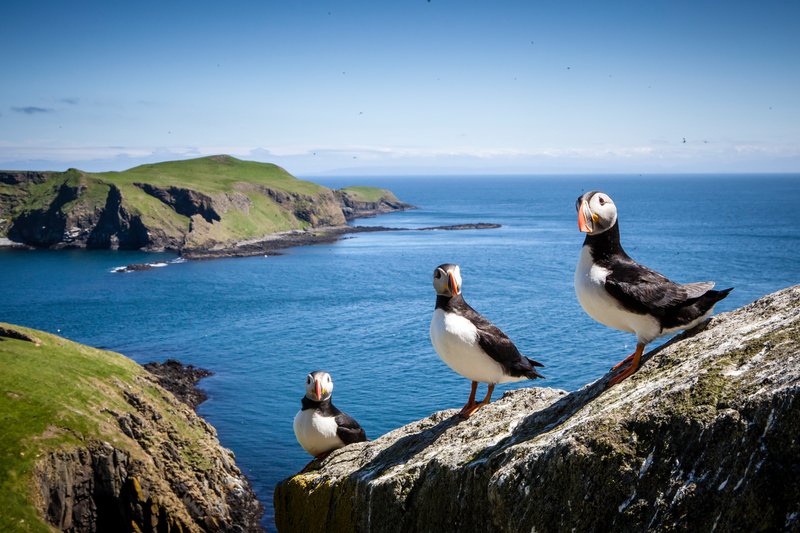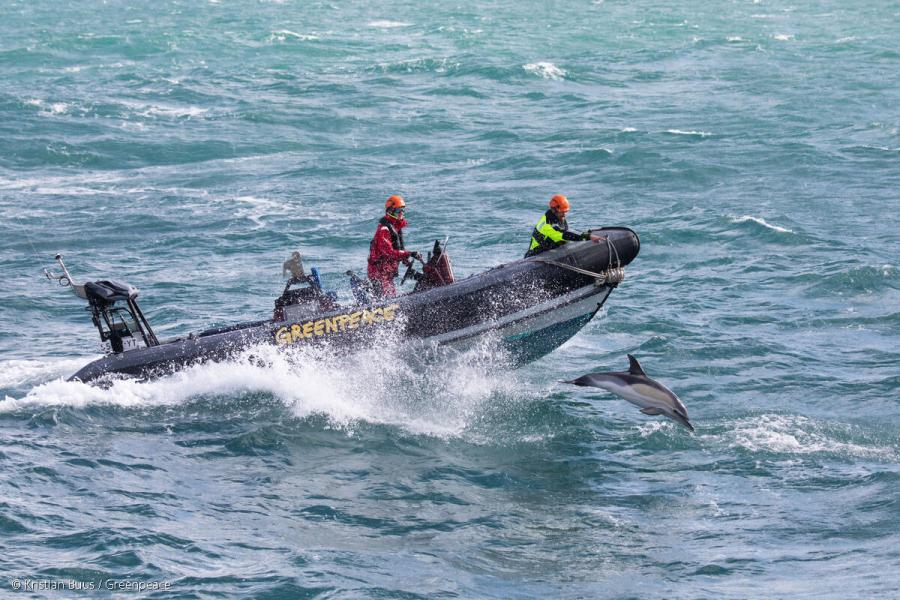It’s sometimes easy to dismiss the seas around the UK as grey, boring, and dull. When we think of oceans full of life, we often think of places far away – but we shouldn’t ignore the amazing marine life that calls our own seas home. Over the past few decades, in many parts of our islands, successful tourist industries have developed watching and enjoying some of this fantastic wildlife, which makes it all the more frustrating that successive governments have been so slow to give it the proper protection it deserves.
Anyone who has visited Britain’s coast or sailed its seas will probably be familiar with the special set of animals that spend time in and out of the water and breed on our coasts; our seabirds and seals. Seabirds and seals depend on safe, sheltered coast lines, plentiful food and clean healthy seas. What people might not know is that the UK is home to globally-significant populations and colonies of both seabirds and seals. We have 40% of the world’s grey seals, and millions of breeding seabirds, including 90% of the world’s Manx shearwaters and the world’s largest colony of northern gannets. Seabirds can travel thousands of miles to breed and raise their young around our shores, but alarmingly, they are also struggling, with well-known fish-eating species like kittiwakes and puffins now under real threat of extinction due to plummeting breeding numbers.

The Shiant Isles are home to large populations of seabirds, including thousands of Puffins, Guillemots and Razorbills found on the cree slopes of the island Garbh Eilean. The islands are also home to northern fulmars, shags, skuas, gulls and kittiwakes. The three main islands are called Garbh Eilean (rough island) and Eilean an Taighe (house island) and Eilean Mhuire (Mary Island) The islands are uninhabited apart from the island of Eilean Taigh which houses a small bothy open to researchers and visitors. Currently nature conservation charity the RSPB are working on the island monitoring bird populations and the success of the recent rat eradication effort.
Greenpeace has brought its ship the Beluga II on an expedition of scientific research around Scotland, sampling seawater for microplastics and documenting the impact of ocean plastic on some of the UK’s most precious marine life.
Britain’s seas are also home to over 40 species of sharks. Spectacular species like thresher sharks and blue sharks are increasingly seen in our waters, whilst many other species live a quiet secretive life under the waves. Basking sharks, at eight metres long, the world’s second largest fish species, flock to sunlit waters each to feast on plankton in warmer months – with these gentle giants filtering tiny morsels of food out of the surface waters. If you’re lucky you might catch a glimpse of them in the shallow sunlit seas around the Scottish Inner Hebrides, or the coast of Cornwall.
Roughly 28 species of whales, dolphins and porpoises are found in UK waters – and many are becoming more common in recent years as their numbers rebound. As well as enigmatic orcas around Shetland, acrobatic Humpback whales, massive fin whales, and resident pods of playful bottlenose dolphins are just some of the animals you can see from boat, and shore-based whale watching trips across the UK, from Cardigan Bay in Wales, to the Scottish Highlands.
Lastly, there are all the ocean creatures you will probably never see. Many species spend their entire lives in, or on, the seafloor. They depend on often-delicate and diverse ecosystems made up of specially-adapted plants, and plant-like ocean animals such as soft corals and sponges. These secret seafloor habitats are home to all sorts of life, from charismatic octopus, cuttlefish, and nurseries for juvenile fish, to tiny shy seahorses. Seahorses, despite being one of the slowest-swimming fish in the sea, have colonised our coastal waters all the way from the English Channel to the Shetland Islands.
The UK’s marine life is amazing and surprising, but it is also damaged, and under increasing threat. Many species are starting to recover after centuries of over-exploitation, but the measures successive governments have taken to protect marine life are inadequate and slow. Marine animals, from tiny seahorses to massive whales, depend on healthy seas, and need safe space to live, breed, and thrive. Sadly, even in what passes for ‘protected’ areas in Britain’s seas, most can still be fished and dredged, wrecking the delicate habitats, destroying the life there, and harming everything that depends upon it.
To hear more about the UK’s waters and the work Greenpeace UK is doing to protect them, invite a Greenpeace Speaker to talk to your community, business or school for free here.
It’s sometimes easy to dismiss the seas around the UK as grey, boring, and dull. When we think of oceans full of life, we often think of places far away – but we shouldn’t ignore the amazing marine life that calls our own seas home. Over the past few decades, in many parts of our islands, successful tourist industries have developed watching and enjoying some of this fantastic wildlife, which makes it all the more frustrating that successive governments have been so slow to give it the proper protection it deserves.
Anyone who has visited Britain’s coast or sailed its seas will probably be familiar with the special set of animals that spend time in and out of the water and breed on our coasts; our seabirds and seals. Seabirds and seals depend on safe, sheltered coast lines, plentiful food and clean healthy seas. What people might not know is that the UK is home to globally-significant populations and colonies of both seabirds and seals. We have 40% of the world’s grey seals, and millions of breeding seabirds, including 90% of the world’s Manx shearwaters and the world’s largest colony of northern gannets. Seabirds can travel thousands of miles to breed and raise their young around our shores, but alarmingly, they are also struggling, with well-known fish-eating species like kittiwakes and puffins now under real threat of extinction due to plummeting breeding numbers.

The Shiant Isles are home to large populations of seabirds, including thousands of Puffins, Guillemots and Razorbills found on the cree slopes of the island Garbh Eilean. The islands are also home to northern fulmars, shags, skuas, gulls and kittiwakes. The three main islands are called Garbh Eilean (rough island) and Eilean an Taighe (house island) and Eilean Mhuire (Mary Island) The islands are uninhabited apart from the island of Eilean Taigh which houses a small bothy open to researchers and visitors. Currently nature conservation charity the RSPB are working on the island monitoring bird populations and the success of the recent rat eradication effort.
Greenpeace has brought its ship the Beluga II on an expedition of scientific research around Scotland, sampling seawater for microplastics and documenting the impact of ocean plastic on some of the UK’s most precious marine life.
Britain’s seas are also home to over 40 species of sharks. Spectacular species like thresher sharks and blue sharks are increasingly seen in our waters, whilst many other species live a quiet secretive life under the waves. Basking sharks, at eight metres long, the world’s second largest fish species, flock to sunlit waters each to feast on plankton in warmer months – with these gentle giants filtering tiny morsels of food out of the surface waters. If you’re lucky you might catch a glimpse of them in the shallow sunlit seas around the Scottish Inner Hebrides, or the coast of Cornwall.
Roughly 28 species of whales, dolphins and porpoises are found in UK waters – and many are becoming more common in recent years as their numbers rebound. As well as enigmatic orcas around Shetland, acrobatic Humpback whales, massive fin whales, and resident pods of playful bottlenose dolphins are just some of the animals you can see from boat, and shore-based whale watching trips across the UK, from Cardigan Bay in Wales, to the Scottish Highlands.
Lastly, there are all the ocean creatures you will probably never see. Many species spend their entire lives in, or on, the seafloor. They depend on often-delicate and diverse ecosystems made up of specially-adapted plants, and plant-like ocean animals such as soft corals and sponges. These secret seafloor habitats are home to all sorts of life, from charismatic octopus, cuttlefish, and nurseries for juvenile fish, to tiny shy seahorses. Seahorses, despite being one of the slowest-swimming fish in the sea, have colonised our coastal waters all the way from the English Channel to the Shetland Islands.
The UK’s marine life is amazing and surprising, but it is also damaged, and under increasing threat. Many species are starting to recover after centuries of over-exploitation, but the measures successive governments have taken to protect marine life are inadequate and slow. Marine animals, from tiny seahorses to massive whales, depend on healthy seas, and need safe space to live, breed, and thrive. Sadly, even in what passes for ‘protected’ areas in Britain’s seas, most can still be fished and dredged, wrecking the delicate habitats, destroying the life there, and harming everything that depends upon it.
To hear more about the UK’s waters and the work Greenpeace UK is doing to protect them, invite a Greenpeace Speaker to talk to your community, business or school for free here.








